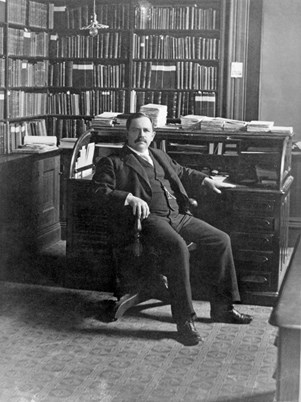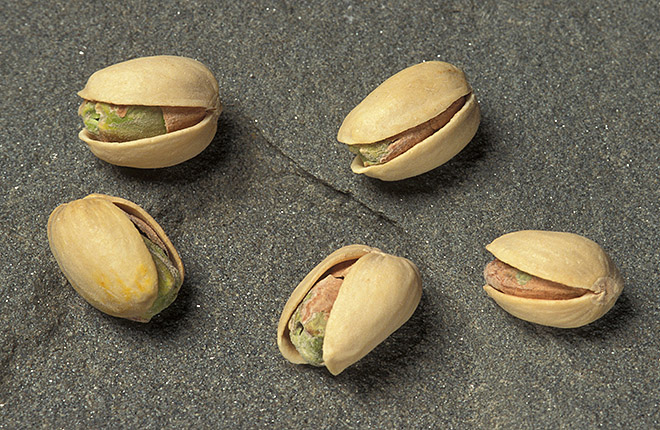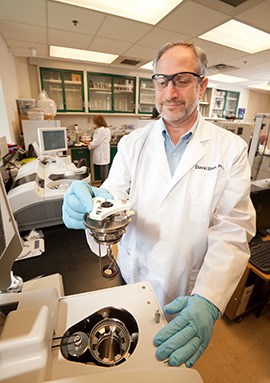Going Nuts Over Calories
|
|
Nutrition is an integral component of one’s lifestyle—either in a positive or negative way. Over the years, nutrition science has become more sophisticated, and research by Agricultural Research Service (ARS) scientists is showing that counting calories isn’t always as simple as it may seem.
For example, while an ounce of almonds has approximately 160 calories, not all of those calories may be used by the human body. This is the idea of “bioavailability.” When food is eaten, it is broken down into its nutritional components and its calories are burned for energy. However, just because nutrients are present doesn’t mean the body will readily use them. The question of whether those nutrients are bioavailable is being examined by scientists in the ARS Food Components and Health Laboratory in Beltsville, Maryland. This lab is part of the Beltsville Human Nutrition Research Center.
In a series of studies, ARS physiologists David Baer and Janet Novotny looked at how many calories of almonds, walnuts, and pistachios are used by the human body. There are a lot of factors to be considered, such as whether the nuts are raw, roasted, or ground and how well they are chewed.
The team found that individuals absorb fewer calories from tree nuts than originally thought. “It was interesting to find that the bioavailable energy, or calories as they are listed on the Nutrition Facts panel, from the nuts was less than predicted,” says Baer.
 In the early 20th century, ARS chemist Wilbur O. Atwater determined a standard way to measure calories in food. (Photo by USDA, D2967-1) |
The results from these experiments were published over the past 7 years. In 2011, Baer and Novotny first looked at pistachios, measuring the “energy value” of the nut. Traditionally, calorie values for foods are calculated using the Atwater system. The Atwater system was developed in the 19th century by American chemist Wilbur O. Atwater and provided a standard way to measure the number of calories in food. Atwater is considered the father of modern nutrition research and education in the United States.
The Atwater system uses a single energy value for each of the main groups of energy nutrients: protein, fat, and carbohydrate. These values are the same no matter which food is being considered. Each gram of protein is said to contain 4 calories, each gram of fat 9 calories, and each gram of carbohydrates 4 calories. These values are then used to calculate the calorie content of a food. The ARS team’s findings are telling us how many of those calories are bioavailable.
In a series of studies with human volunteers, the researchers provided a controlled diet and collected fecal and urine samples to determine how much fat, protein, carbohydrate, and energy was absorbed from tree nuts.
|
|
In their 2011 study, Baer and Novotny found the calorie uptake from pistachios was 22.6 calories per gram, which is 5 percent less than the currently accepted 23.7 calories per gram. An ounce of pistachios has 161.9 calories, but only 153.8 calories are bioavailable. That may not sound like a lot, but a calorie reduction of 5 percent can be quite significant on a daily basis. There’s also a bonus. In their study, they found that pistachios lowered LDL cholesterol by 6 percent but didn’t significantly change total plasma cholesterol.
“Providing accurate information about metabolizable energy (ME) content—calories—of foods is important for reliable food labeling and has health ramifications,” says Novotny.
In a study of walnuts, the team found an even greater discrepancy between the Atwater factors and the ME value. “We found that a 1-ounce serving of walnuts contained 146 calories, which is 39 calories—21 percent—less than the Atwater value,” says Baer. “This finding could explain the observations that consumers of nuts do not gain excessive weight.”
Baer and his colleagues also looked at almonds, and here, too, found the trend continuing. Almonds were found to have 32 percent fewer calories of ME than determined by the Atwater factors: 129 calories instead of 168-170 calories.
The way nuts are processed also impacts their ME value.
“We measured the ME in different forms of almonds: whole raw almonds; whole roasted almonds; chopped roasted almonds; and almond butter,” says Baer. “Again, the Atwater factors overestimated the ME of whole raw, whole roasted, and chopped roasted almonds by 25 percent, 19 percent, and 17 percent, respectively. These differences are likely related to the hardness and fracture properties of the almond and the degree of structural breakdown during processing and chewing.”
“We’ve come a long way in showing that the actual ME in tree nuts is different from the calories on the labels based on the traditional Atwater factors,” says Baer. “Perhaps this will start the hard work of doing the same for other foods we eat. Nutrition is becoming highly individualized, and these differences will need to be considered.”—By Sharon Durham, ARS Office of Communications.
Key Facts
- ARS scientists studied the nutrient and calorie content of tree nuts.
- Tree nuts provide fewer calories than shown on labels.
- How nuts are processed affects their caloric availability to the body.
Full Story









